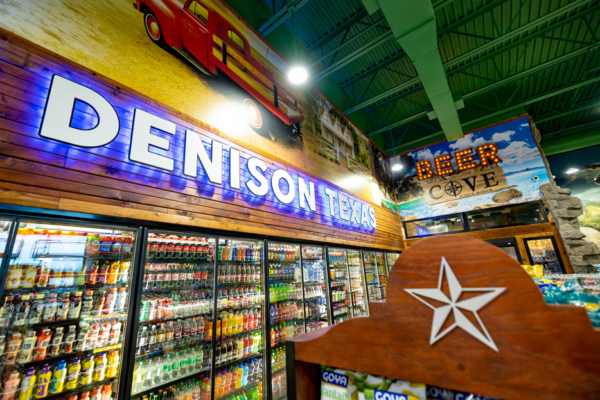Article created for the digital issue of
From supply chain disruptions to shifting customer demands to ongoing labor shortages, the past few years have been fraught with challenges for retailers.
Technology is playing a vital role in helping companies meet those challenges head on. The right systems enable real-time and automated inventory management while also helping retailers identify shifts in purchasing patterns, balance what consumers are buying with what is available in the supply chain, and optimize employees’ time.
“Automation can facilitate data driven decisions that automate the supply chain end to end, including automated forecasted, auto order, auto dispatch and sales analysis,” said Sid Gaitonde, president, enterprise productivity at PDI. “Generally, automation eliminates or lessens the human element so that employees can focus on other tasks that are both beneficial to your business and to their career development, which is particularly important with today’s labor challenges.”
Technology is generating more data than ever, which can provide new and valuable insights. Gaitonde said fully electronic integrated solutions can automate the process without paper or manual work.
Managing Supply Chain Challenges
Technology can give retailers the ability to get analysis at any level, down to the individual SKU. “If you’re stocking a lot of Diet Coke Vanilla and people want Coke Zero, you’re missing the boat,” Gaitonde said. “Can your ERP system be dynamic and help you keep up with a market shift? How are you in touch with the latest SKUs people are buying.”
Plus, the ongoing supply chain challenges mean retailers need to be able to identify what inventory and how much they need to order based on sales and lead time extensions because of anticipated delays, Gaitonde said.
Many retailers have had to substitute products they normally stock with what is available, and Gaitonde recommended they conduct a sales analysis to know if substitute items are resulting in more, less or the same sales, and how to optimize accordingly.
With data, operators know what customers are buying where and at what price, which creates the opportunity for retail price optimization and promotions to improve basket sizes. “It isn’t just the data. It’s the insights. It’s what you do with that data and how it is integrated across the business that matters,” Gaitonde said.
Automating the Process
Automated inventory management can be particularly useful for certain products, including fuel. Gaitonde explained that with automation, if the fuel dips, the system automatically orders a truckload to drop at the store.
“You don’t want your store managers to monitor the gauges and call something in. If you do that, you’re using more manpower, you’ll run out of fuel and you’ll miss an opportunity,” he said, adding that automation frees up labor. “If you automate it, the person inside the store doesn’t have to spend a lot of time placing the order and stocking the inventory.”
Freeing up labor can help boost customer service. “Transform your employees from doing hourly work to being more customer service representatives that are in charge of your brand and loyalty,” Gaitonde said, adding that customers tend to return because of the people. “The person can have a memorable exchange and interaction and that is why they keep coming back to that store instead of a store across the street. To do that, you have to free up the employee.”
Linnea Geiss, chief operating officer of PDI, said retailers should think through tasks that can be done by technology instead of with people. “Can you streamline daily reconciliation, inventory management, and the ordering and delivery process that makes the whole supply chain run?” Instead of using automation to eliminate people, use it to eliminate tasks so you can free up people for the things that move your business forward,” she said.
On the flip side, scarce talent means that it is sometimes hard to implement technology. Geiss recommends retailers make sure they are getting the most out of solutions they already have. “Are you taking advantage of new modules? Are you aware of the new features that are coming out? Have you tuned your business process to be able to capitalize on all the operational capabilities that are in the system? Try to do more with your solutions out of the box because customizations are costly and take away your team’s time and focus and really slow down your ability to realize the value,” she said.
Meeting Changing Needs
Technology is not only helping retailers respond to current changes but can also help them prepare for upcoming transitions, Gaitonde explained. “EVs are coming in and they are going to be more prevalent,” he said. “Things are changing. Convenience stores are going to have to transform to a destination.”
Plus, almost 40% of consumers report that they decide what convenience items they’re going to buy before they even get to a store, which means retailers need to have an omni-channel presence, Gaitonde said.
“People are going online and saying, ‘I’m going to get a pizza,’ and they decide between Pizza Hut, Dominos or the c-store down the road. You want to be in that network of online dining, so you don’t get left out,” Gaitonde said, adding that locations need to be ready to take orders online, which may mean their technology must evolve. “You’re going to have to have integration in an omnichannel interface into your ERP and POS to allow you to sell that product whether online on a desktop or a mobile application. If the customer logs in and creates and order for a Twinkie or a Coke, you have to make sure you take that order.”
Jimmy Frangis, chief executive officer of PDI, said retailers have to meet their customers where they are so they can transact in their preferred way. That could mean leveraging mobile apps that are in combination with a loyalty program and enabling consumers to interact electronically. “I think all of that is going to be important as we move forward. People can interact in their stores in the way they want to, and we should be prepared to give them those choices,” he said.
That choice also extends to self-checkout in the store. “In a retail environment, there are some real peaks in demand and throughput of customers, so self-checkout gives people an option if they want to get in and out quickly,” Geiss said. “I think people who have deployed it have used it to augment from a cashier perspective and not replace it. That gives you a little more optionality about how you staff your store.”
Determining the Value
Those at PDI expect to see the amount of available data increase throughout 2023, which Geiss said will make it more important for retailers to determine which data is useful.
“Data for its own sake isn’t as valuable without the offers and the insights and the actions that you’re able to take as a result of that data. Having an API or interface doesn’t add value on its own if it isn’t making something easier, faster or less error prone,” Geiss said.
// This article was created for Stop Watch magazine, the magazine of the NATSO Foundation. The NATSO Foundation is the research, education and public outreach subsidiary of NATSO, Inc. The NATSO Foundation provides programs and products to strengthen travel plazas’ ability to meet the traveling public's needs through improved operational performance and business planning. Visit www.natsofoundation.org for more information. (Donate to the NATSO Foundation here.)
Subscribe to Updates
NATSO provides a breadth of information created to strengthen travel plazas’ ability to meet the needs of the travelling public in an age of disruption. This includes knowledge filled blog posts, articles and publications. If you would like to receive a digest of blog post and articles directly in your inbox, please provide your name, email and the frequency of the updates you want to receive the email digest.




